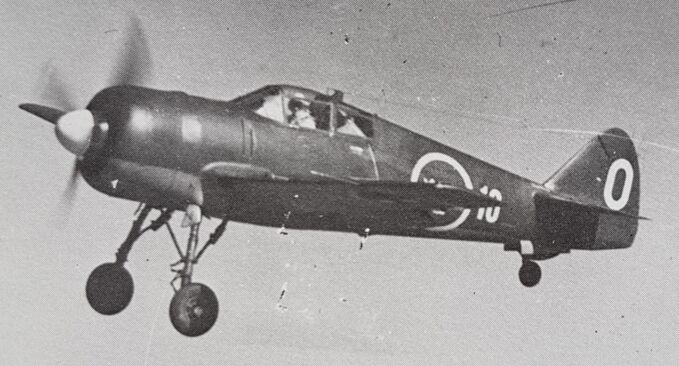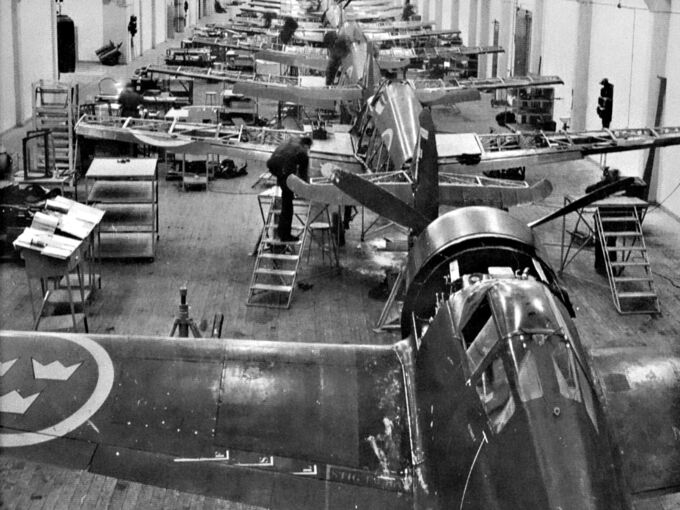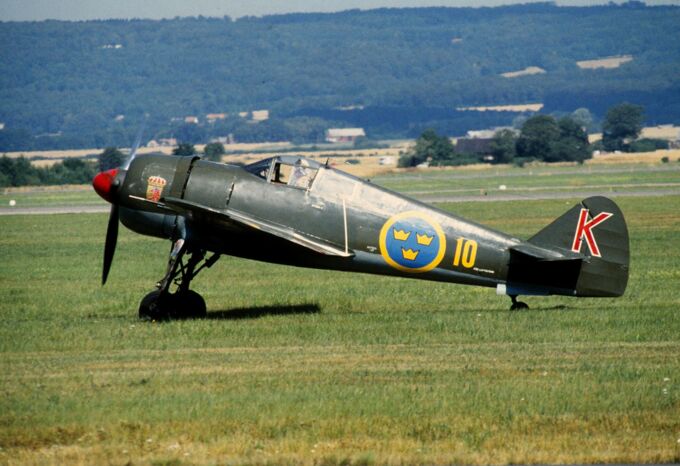Sweden's desire to remain neutral was tested as World War 2 engulfed their neighbors. With ever-improving technology to consider, Sweden made a bold choice to go its own path and produce its own domestic fighter aircraft to be able to protect their airspace and challenge the existing fighters used by other countries. The result was the FFVS J22 fighter jet. Here is its story on how it was made to serve the Swedish military.
Aircraft Development
As World War 2 started to break out in Europe in 1939, a nervous neutral Sweden watched as the Soviets attempted to advance on Finland and Germany amassing power and heading for France. The Swedish military realized their fighter aircraft, the older Gloster Gladiator J8 biplane fighters, was largely outdated compared to up-and-coming Bf 109s and early Soviet fighters like the I-301 (later known as LaGG-3). With SAAB’s current production plant cranking out SAAB 17 reconnaissance/bombers and SAAB 18 bombers in development, no room, mechanics, or design team personnel were available to spare for developing and creating a modern fighter airplane for the Swedish Air Force.
Desperate for immediate aircraft, Sweden reached out to the United States with interest in the Seversky P-35 (J9) and the P-66 Vanguard (J10), which almost 250 of these aircraft were ordered; however, as fate would have it, Germany invaded Norway in mid-1940 resulting in the United States halting the exporting of all weapons through an embargo with any foreign country except Great Britain. A new look cast light on the Finnish fighter, the VL Myrsky, and the Soviet Polikarpov I-16; however, the aircraft did not make the cut and did not meet the requirements that the Swedish military was looking for. Though the Mitsubishi A6M Zero was an option, attempting to deliver these from Japan was not feasible. Instead, a decision was made to build a local fighter; however, as a stop-gap measure, several CR.42 (J11) and Reggiane Re.2000 (J20) fighters were purchased.
Since SAAB had its hands full with current projects, a new aircraft manufacturer and manufacturing facility was created to build a new fighter, the Royal Air Administration Aircraft Factory in Stockholm, or FFVS, under Bo Lundberg's direction. The new fighter, designated J22, was to be a monoplane constructed with a steel airframe that was covered in plywood, giving it sufficient strength but keeping its weight down to a manageable level. This aircraft had many similarities with fighters being developed in the West, especially since the engine it utilized was an unlicensed copy of the Pratt & Whitney R-1830 Twin Wasp. The nose of the aircraft housed the radial engine while the cockpit sat behind it, situated just behind the leading edge of the wings. The fuselage tapered from the front to a narrow rear-ending at the tailplane where the vertical and horizontal stabilizers are located. The wings are set low on the fuselage, and the landing gear retracts into the fuselage as opposed to the wings on many European and Soviet aircraft.
The aircraft was a bit awkward for the pilots while taxiing as the nose sat fairly high and blocked a significant portion of the pilot’s field of view, requiring the pilot to waggle the tail while taxiing to ensure nothing was in front of them, however after the plane took off, as many Swedish pilots noted, it was a very pleasant aircraft to fly. Due to the strong frame and the light bodywork, the controls of the aircraft were very responsive to the pilot’s inputs and much like the Spitfire aircraft of the British Royal Air Force; pilots thoroughly enjoyed flying these planes. Pilots also claimed that during mock dogfights with P-51 (J26) fighters, the J22-A could hold its own all the way up to around 4,000 – 5,000 m (13,000 – 16,000 ft); any higher the aircraft lacked a supercharger which caused the engine performance to significantly drop, and at that point, the aircraft became a beast to control. Therefore operations were kept at 4,000 m or below.
There were three versions of the aircraft built, the J22A (or J22 UBv “Ursprunglig Beväpning” (original armament)) was the first production aircraft which though a good aircraft, was considered lacking in the firepower department due to it only having 2 x 8 mm and 2 x 13.2 mm machine guns. However, the second version, the J22-B (or J22 FBv “Förbättrad Beväpning” (improved armament)) was the same aircraft; however, the two 8 mm machine guns were removed and replaced with two more 13.2 mm machine guns for a total of four (two in each wing). Several were modified into reconnaissance aircraft, however later they were converted back into fighters; these were known as S 22-1 aircraft.
These aircraft were well-liked by pilots and even more well-liked by their maintainers due to their ease of maintenance, having enough parts on hand ensured these aircraft remained airworthy and ready to go. None were ever exported to a foreign country and all served only under the Swedish flag until the last one was retired in 1952.
Excerpt taken from an interview with Ove Müller-Hansen, Squadron Commander, 2nd Squadron (2:a divisionen), F10 Wing, Ängelholm
Q: I have read that you once ended up in a dogfight with a FW 190?
A: "That is completely wrong. What happened was that I was over Malmö Harbor in a fight in my J22 with a Heinkel 111. He was shooting at me and I was shooting at him, trying to make him leave Swedish territory. I finally got him smoking. He was probably on his way to Copenhagen, but I don't think he made it as he was losing altitude. I saw an aircraft behind me and I thought it was a FW 190 as they also were stationed in Copenhagen and I pulled away as much as I could and was able to lose him. It turned out that it was my wingman. He was a little late taking off so he was rather far behind me. The J22 was very similar to the FW190 so it was difficult to tell them apart. We were really scared of the FW 190. We could probably out-turn them but we really didn't want to try... My wingman was a little angry at me after this incident, but I told him what happened and he understood."
Bibliography
- Langbro, H. (2003, January 15). F.F.V.S. J22 Fighter Aircraft From a technical perspective. Retrieved from https://web.archive.org/web/20120213150814/http://www.hobbybokhandeln.se/j22/pilot.htm.
- Fridsell, M., & Waligorski, M. (2006, September 22). FFVS J 22 in Detail. Retrieved from https://www.ipmsstockholm.org/magazine/2002/01/stuff_eng_detail_j22.htm.
- Aceto, G. (2019, July 19). The Saab J21. Retrieved from https://www.historynet.com/the-saab-j21.htm.




